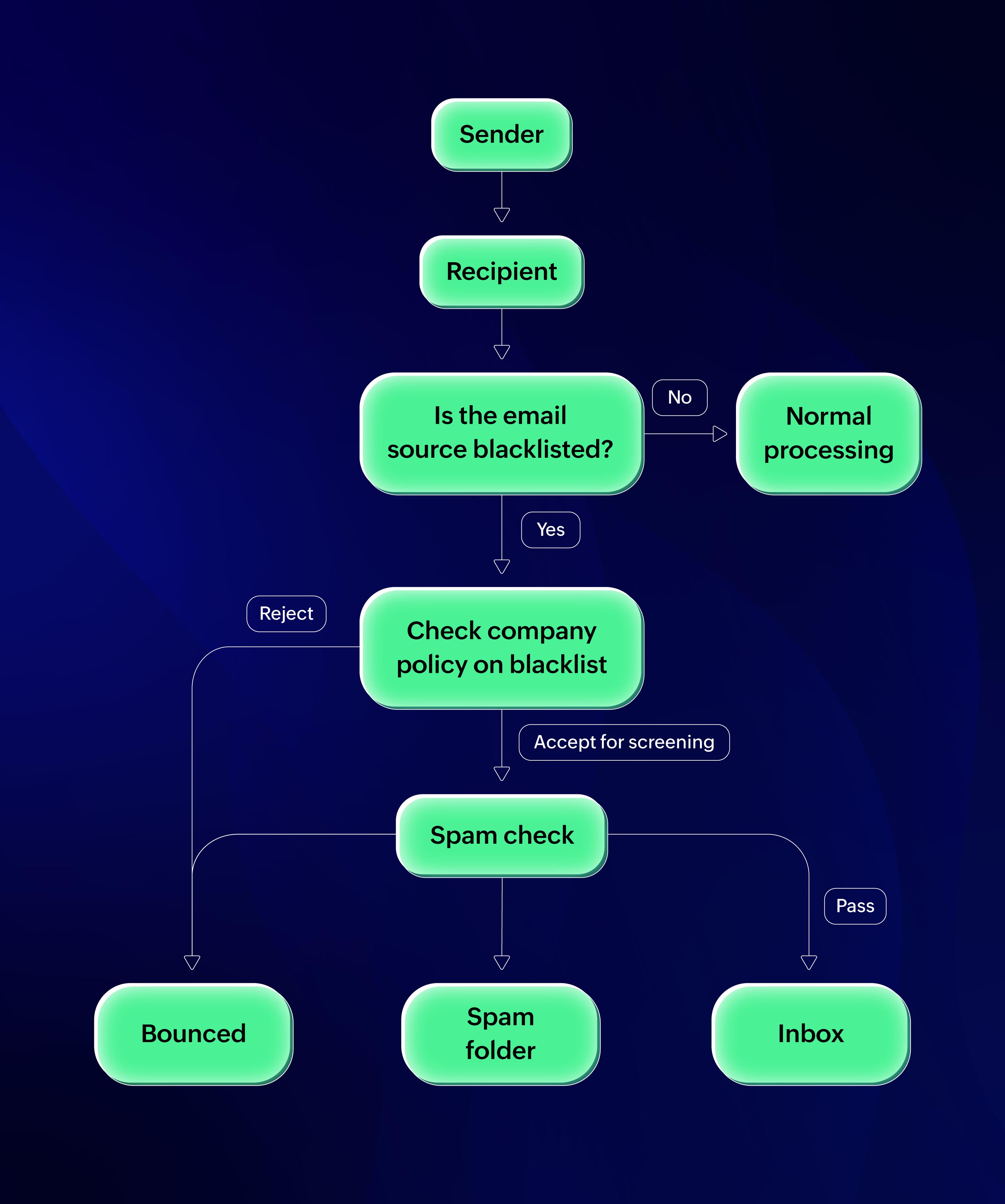Blacklisted/blocklisted email
What is a blacklisted email or blocklisted email?
A blacklisted email refers to email addresses, domains, or IPs that have been flagged due to a severely damaged sender reputation as a result of spam, abuse, or non-compliance activities. Specialized lists are maintained to keep track of these blacklisted emails. These lists are used by email providers, ISPs, and anti-spam vendors to block or filter incoming email from sources included in the blacklist.
Types of blacklists
While the main function and purpose of email blacklists or blocklists is the same, who and what makes the list can be used to categorize it into types:
Public blacklists: Lists maintained by independent services. These lists are often consulted by many email systems.
Private/ISP-specific blacklists: Lists managed by individual ESPs or ISPs. They are tailored and built by each provider's internal spam filters.
IP blacklist: These are lists that flag sending server IPs that are involved in suspicious or malicious activities.
Domain blacklist: These lists collate email domains that are involved in spam or non-compliant activities.
How is an email blacklist built?
Blacklists are built primarily based on spam reports. A blacklist can include either emails being manually marked as spam or emails being flagged by automated filters. In such instances, a note is passed on to the blacklist. The blacklist provider will map yellow cards to the sender for every instance. If and when the sender collects enough complaints or yellow cards, the sender IP or domain will be added to the blacklist. This will be attributed to the sender receiving a red card. This process is also followed for high bounce rates.
Another way to earn a place on a blacklist is if someone personally requests a blacklist site to include your IP or domain. If the request is backed by proper justification and approved by the list provider, your email could be blacklisted.
While spam complaints dominate the reason for blacklisting, there are a few other causes that are taken into account when an email is blacklisted:
High spam reports on emails sent by the sender.
Poor recipient email addresses that cause high bounce rates due to invalid, non-existent or spam trap addresses.
Hacked accounts sending out malicious emails containing malware.
Sending non-compliant content with misleading subject lines or banned promotional tactics.
Poor engagement metrics with low open or click rates.
Technical misconfiguration with missing or mismatches SPF, DKIM, or DMARC settings.
Abuse of a shared IP used by your business to send emails.
How do you find out if your email is blacklisted?
Depending on which blacklist you've been added to, the extent to which your deliverability is affected will differ. The more popular the list is among email service providers, the more easily you'll notice the change in deliverability.
While the effects differ, as a rule of thumb, there are some signs that tell you that your email might be blacklisted:
A sudden drop in delivery rates without any apparent change to sending behavior.
A decline in open rates.
A spike in bounce rates, especially hard bounces.
In some cases, explicit notification from your email service provider.
Once you notice these signs, you can check if your email is part of any blacklists. Check popular blacklists like Spamhaus Block List (SBL), Barracuda Reputation Block List, SpamCop, or URIBL. You can even use online tools like MXToolbox or Wombatmail.
How does an email blacklist affect your email delivery?
It's pretty clear that being on an email blacklist will affect your deliverability. It will sabotage your email delivery and lead to:
Blocked email delivery.
Emails being flagged by spam filters and ending up in the spam folder.
Your sender reputation taking a hit, affecting future emails.
Here's how the email blacklists play a role in the delivery workflow:

Every ESP has a set of blacklists that they trust or, in some cases, they have their own blacklist. When an email is received by the ESP, it refers to these blacklists to see if the sender is on the list. If the answer is no, the email goes through the normal process of being processed. If the answer is yes, depending on the company's policy on blacklisted emails, the emails can be rejected or directed to the receiver's spam folder.
Removing your email from a blacklist/blocklist
Once you find that your email has been blacklisted, there are some steps that you can take to attempt removing it from the list.
Identify the blacklist your email is on by using monitoring tools like MXToolbox.
Address the root cause, like authentication issues or content spam.
Submit a delisting request with the blacklist provider.
Test your emails after delisting and monitor the status of your emails and continue to follow the best practices implemented.
Best practices to prevent your email from being blacklisted
Here are some tips and practices to follow to prevent your email from ending up on a blacklist or blocklist:
Fix authentication issues with SPF, DKIM, or DMARC configurations.
Clean your email recipient list so that recipients who haven't consented or outdated email addresses aren't included.
Employ double opt-in to verify that the email addresses provided are correct.
Avoid sending emails with high spam content or spam-triggering words.
Improve email design to be accessible across devices.
Monitor engagement metrics like delivery rate, opens, and clicks.
Warm up your sending infrastructure by gradually increasing volume from new IPs or domains.
Monitor and analyze unsubscribe requests and spam reports.